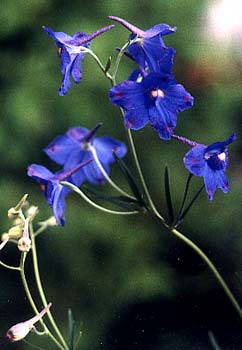
'Blue Butterfly'
Chinese Larkspur
It is blue-butterfly day here in spring,
And with these sky-flakes down in flurry on flurry
There is more unmixed color on the wing
Than flowers will show for days unless they hurry.
But these are flowers that fly & all but sing:
And now from having ridden out desire
They lie closed over in the wind & cling
Where wheels have freshly sliced the April mire.
-Robert Frost
(1874-1963)
(1874-1963)
Blue Butterfly Larkspur (Delphinium grandiflorum) has just the bluest gentian-blue flower. It's not a wussy little Baby's Breath tiny blue flower either. The cut flowers are so extraordinary that this species of Delphinium is sometimes called "Bouquet Larkspur." It's also called Chinese Larkspur, sometimes Siberian Larkspur, because the native range of the species includes northern China, Mongolia, & the steppes of eastern Siberia, where it erupts in sunny meadows & grows swiftly due to the short growing seasons.
The individual blossoms are not on a spike like most larkspurs, but grow amidst the slender foliage, & the sepal spur which give larkspurs their name is a bit more subtle than for many others within the genus, though the spur gets to be just as big after it goes to seed.
It wants rich moist soil in a sunny location. It should never experience drought. It would adapt to a little too much shade before it would adapt to dryness. During the blooming season it might enjoy regular fertilizing with 5-10-5 flower food, much as would be done for cape fuchsias or Clematis during the flowering months. However, we do not use a great deal of supplemental fertilizer in our gardens, & did not do much extra for this delphinium, & it did not complain.
Removal of spent flowers will induce rebloom, though it might reseed itself if permitted to go to seed. As it is so shortlived it might be preferrable to encourage reseeding, even though cultivars don't often prove to be true to the parent if grown from seeds.
Taking the occasional bloom for bouquets & leaving others to go to seed may provide a balance that will get some later rebloom. Seeds can also be collected from the plant to be planted in spring. Unfortunately the seedlings look awfully like weeds & apt to be accidentally pulled before big enough to recognize as delphinium. Seedlings may also have trouble getting started if the ground is mulched, yet they do prefer to grow in place over being started in trays.
Though often described as reaching only a maximum of fifteen inches tall including flower, ours quicky reached 26 inches. There are dwarf cultivars however that really do remain smaller.
Because of this flower's beauty, I'm sure it would be more popular but for its tenderness, being susceptible to diseases, fungus, snail & insect attack, at risk if overheated, will be killed by non-organic gardeners who use pre-emergent weed killers which also kill delphiniums, & are just generally shortlived.
Though nominally a perennial, D. grandiflorum is generally expected to be annual or bi-annual. With such fast growth, however, they can be planted with the expectation that they will prove to be annuals, but if they do happen come back in the following year, a nice surprise not definitely to be expected.